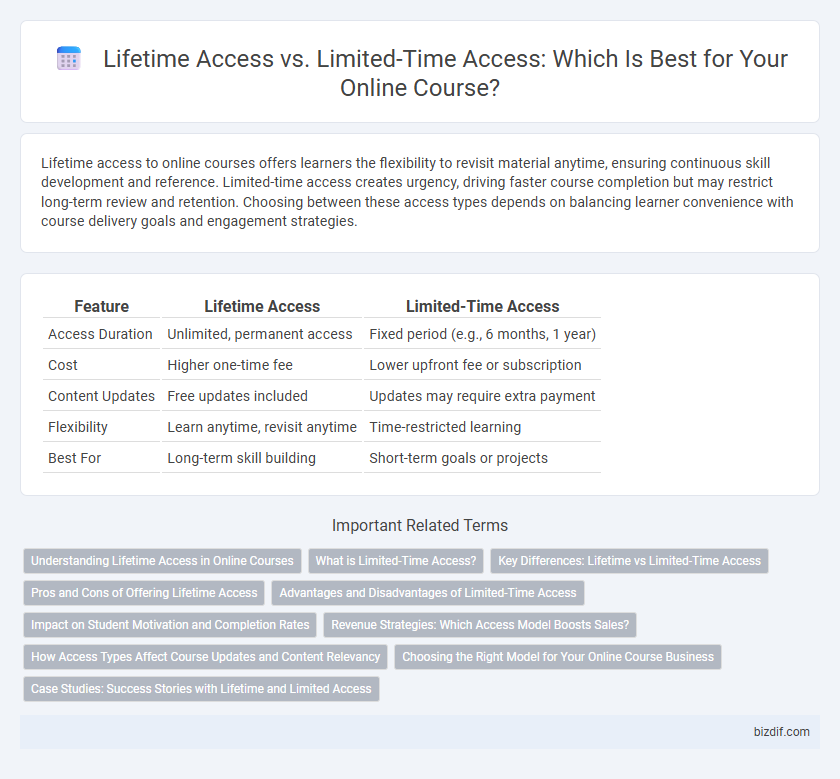Lifetime access to online courses offers learners the flexibility to revisit material anytime, ensuring continuous skill development and reference. Limited-time access creates urgency, driving faster course completion but may restrict long-term review and retention. Choosing between these access types depends on balancing learner convenience with course delivery goals and engagement strategies.
Table of Comparison
| Feature | Lifetime Access | Limited-Time Access |
|---|---|---|
| Access Duration | Unlimited, permanent access | Fixed period (e.g., 6 months, 1 year) |
| Cost | Higher one-time fee | Lower upfront fee or subscription |
| Content Updates | Free updates included | Updates may require extra payment |
| Flexibility | Learn anytime, revisit anytime | Time-restricted learning |
| Best For | Long-term skill building | Short-term goals or projects |
Understanding Lifetime Access in Online Courses
Lifetime access in online courses provides learners with unlimited, indefinite use of course materials, fostering long-term skill development and allowing flexible learning schedules. This model enhances continual education by granting students the ability to revisit content for updates or review without time constraints. The value of lifetime access lies in its support for deeper mastery and ongoing knowledge retention compared to limited-time access, which restricts availability to a fixed period.
What is Limited-Time Access?
Limited-time access in online course creation restricts learners to a specific period, such as 30, 60, or 90 days, during which they can access course materials. This model encourages timely completion and helps creators manage licensing, content updates, and support resources efficiently. It often includes automatic expiration of access, motivating students to engage consistently within the allotted timeframe.
Key Differences: Lifetime vs Limited-Time Access
Lifetime access grants learners unrestricted entry to course materials indefinitely, allowing flexible pacing and revisiting content anytime. Limited-time access restricts availability to a set duration, encouraging focused learning but potentially causing pressure to complete modules promptly. Evaluating learner needs and content relevance helps determine the ideal access model for maximizing engagement and value.
Pros and Cons of Offering Lifetime Access
Offering lifetime access to an online course provides students with the flexibility to learn at their own pace and revisit content indefinitely, enhancing long-term value and satisfaction. This model can increase enrollment by appealing to learners seeking ongoing reference material, but it may reduce urgency for course completion and complicate content updates or support. Course creators must balance the potential for sustained revenue against challenges in maintaining course relevancy and managing extended student engagement.
Advantages and Disadvantages of Limited-Time Access
Limited-time access to online courses creates urgency, encouraging faster completion and active engagement, which can enhance learning outcomes. However, this access model may hinder students who need more flexibility due to unpredictable schedules or personal commitments, potentially reducing overall course satisfaction. It also limits the ability to revisit content for long-term retention or skills reinforcement, which can be a disadvantage compared to lifetime access.
Impact on Student Motivation and Completion Rates
Lifetime access empowers students with the flexibility to learn at their own pace, significantly boosting motivation and increasing course completion rates by reducing time pressure. Limited-time access creates a sense of urgency, which can drive short-term motivation but may also induce stress and lower overall completion for students who require more time. Understanding how access duration influences learner engagement helps course creators optimize structures to maximize student success and satisfaction.
Revenue Strategies: Which Access Model Boosts Sales?
Lifetime access often drives higher upfront revenue by offering customers unlimited course usage, fostering long-term value perception and reducing churn. Limited-time access creates urgency, encouraging quicker purchases and potential recurring revenue through renewals or upsells. Course creators aiming to maximize sales must analyze target audience preferences, pricing strategies, and content update frequency to choose the optimal access model.
How Access Types Affect Course Updates and Content Relevancy
Lifetime access allows learners to benefit from continuous course updates and the latest content, ensuring ongoing relevancy in a rapidly changing field. Limited-time access restricts learners to a fixed content snapshot, potentially missing crucial updates and trending information after expiration. Instructors must balance update frequency and access duration to maximize content effectiveness and learner satisfaction.
Choosing the Right Model for Your Online Course Business
Choosing the right access model for your online course business significantly impacts student engagement and revenue generation. Lifetime access encourages continuous learning and builds long-term value for users, increasing course completion rates and positive reviews. Limited-time access creates urgency that drives quicker purchase decisions and allows creators to update content regularly, maintaining course relevance and exclusivity.
Case Studies: Success Stories with Lifetime and Limited Access
Case studies reveal that lifetime access to online courses fosters deeper learner engagement and long-term skill retention, as students revisit material at their own pace. Limited-time access drives urgency and boosts completion rates but may lead to rushed or incomplete learning experiences. Success stories highlight that lifetime access often results in higher learner satisfaction and better post-course application of knowledge.
Lifetime access vs Limited-time access Infographic

 bizdif.com
bizdif.com